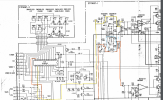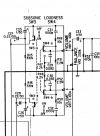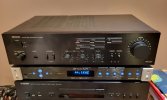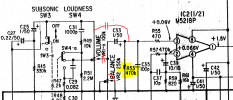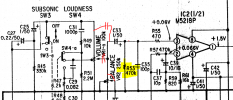Hi all,
I have a Denon PMA-300V (a model from late 1980s). It works fine, except for one thing.
Symptoms:
1. When the volume knob is at 0 (5pm position), Left channel is fully silent, but the Right is still audible. Very quiet, but still audible
2. Note: this barely audible sounds like low frequences are gone, only high frequencies remain
3. No difference to the residual sound whether Loudness and Subsonic are pressed or not
4. Once the volume knob is just slightly off (5.30pm) both L and R sound equally, there is no disbalance, there is no lack in low frequency
5. [Update] It does respond to Balance knob, i.e. the residual sound in Right goes away when Balance is rotated to the Left
I was looking at chematics and tried to trace to Volume control. The version I downloaded from the internet is a low quality scan
@Doodski can you pls check if hifiengine has a better one?
I hope I correctly traced through from 11/13 terminals of TC9152P (output from the input selector) to the Volume and Balance (yellow and red lines).
Is the Volume resistor the only suspect? Or can the leakage be because of some other component?
I have one doubt. If it was just the leaking volume resistor, would the "quiet sound" be full frequency? But it is just highs, no lows. So maybe something else?
This is not an expensive device, so it is more curiousity than necessity. No problem if it is never fixed.
But if experts can have a look, would be nice
@Doodski @Zapper @Dimitri @Glint and others? Thanks!
I have a Denon PMA-300V (a model from late 1980s). It works fine, except for one thing.
Symptoms:
1. When the volume knob is at 0 (5pm position), Left channel is fully silent, but the Right is still audible. Very quiet, but still audible
2. Note: this barely audible sounds like low frequences are gone, only high frequencies remain
3. No difference to the residual sound whether Loudness and Subsonic are pressed or not
4. Once the volume knob is just slightly off (5.30pm) both L and R sound equally, there is no disbalance, there is no lack in low frequency
5. [Update] It does respond to Balance knob, i.e. the residual sound in Right goes away when Balance is rotated to the Left
I was looking at chematics and tried to trace to Volume control. The version I downloaded from the internet is a low quality scan
@Doodski can you pls check if hifiengine has a better one?
I hope I correctly traced through from 11/13 terminals of TC9152P (output from the input selector) to the Volume and Balance (yellow and red lines).
Is the Volume resistor the only suspect? Or can the leakage be because of some other component?
I have one doubt. If it was just the leaking volume resistor, would the "quiet sound" be full frequency? But it is just highs, no lows. So maybe something else?
This is not an expensive device, so it is more curiousity than necessity. No problem if it is never fixed.
But if experts can have a look, would be nice
@Doodski @Zapper @Dimitri @Glint and others? Thanks!
Attachments
Last edited:

